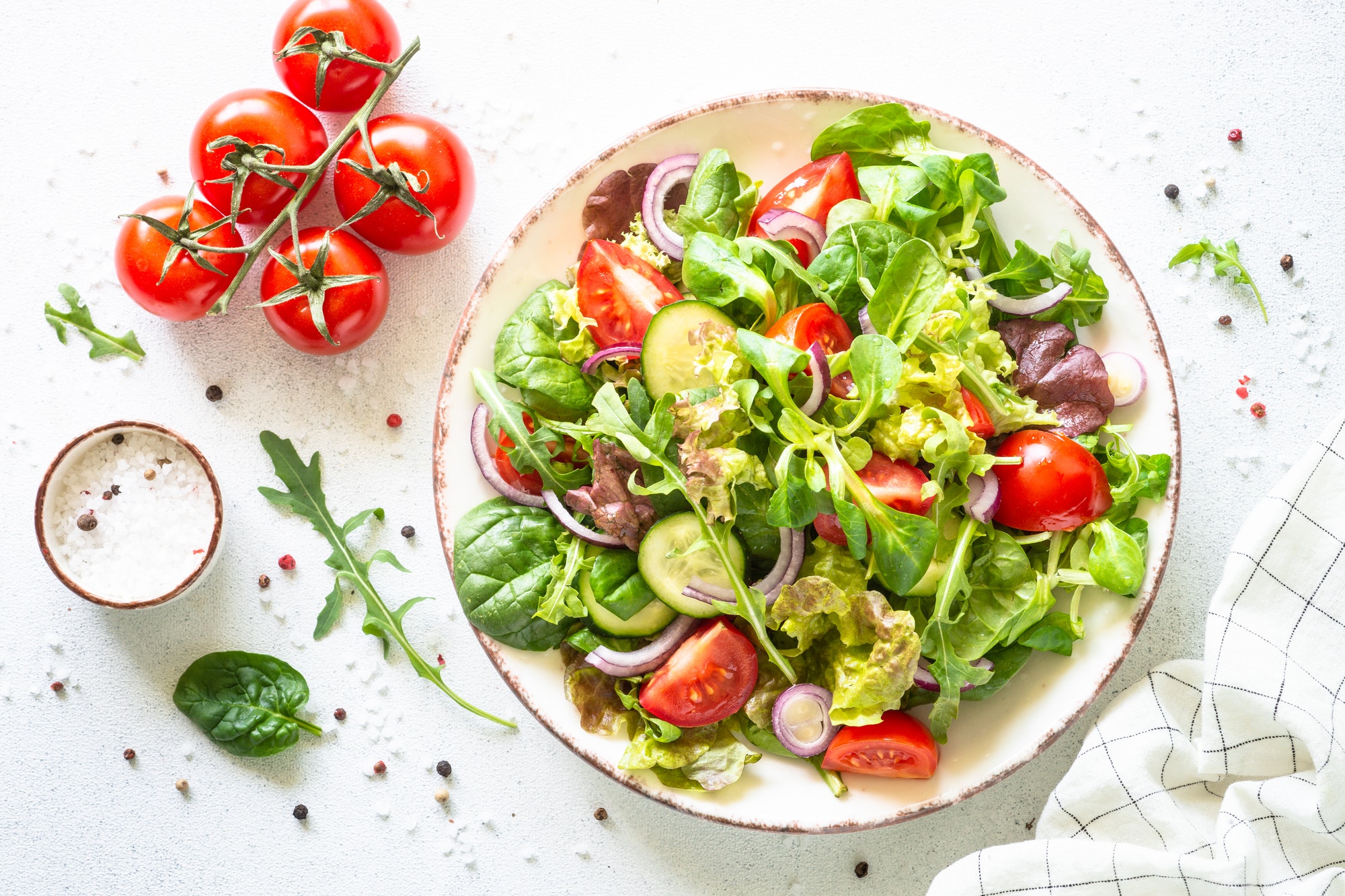What Techniques Ensure a Perfectly Balanced Gourmet Greek Salad with Homemade Pita?

A Greek salad, an amalgamation of fresh, vibrant ingredients all married together with a zesty homemade dressing, is a dish that delivers a burst of Meditteranean flavors in every bite. However, mastering the perfect balance of flavors and textures is an art in itself, requiring a deep understanding of ingredients, an adeptness in salad layering techniques, and a keen sense of taste.
Whether you’re a passionate home cook, a curious food enthusiast, or an aspiring vegan looking to incorporate more fresh, plant-based meals into your diet, this guide will provide you with the essential techniques to create a perfectly balanced gourmet Greek salad and homemade pita. We will also incorporate variations like the Fattoush salad and chicken Greek salad for non-vegan readers.
Topic to read : What’s the Key to a Perfectly Creamy Gourmet Pumpkin Soup Topped with Roasted Seeds?
1. Selecting and Preparing the Ingredients for the Greek Salad
The quintessential Greek salad is a symphony of fresh, seasonal ingredients. Ripe tomatoes, crisp cucumbers, piquant red onions, briny Kalamata olives, and creamy Feta cheese form the base of this salad, each bringing their unique flavor and texture to the mix.
When selecting tomatoes, opt for vine-ripened or beefsteak tomatoes that are firm yet yield to gentle pressure. They should have a deep, vibrant red color, indicating maximum flavor. Cucumbers should be firm, without any soft spots, and red onions should be glossy and hard with no signs of sprouting. Kalamata olives, a Greek variety, add a delicious, salty contrast to the vegetables. Look for olives that are plump and dark purple, preferably stored in olive oil for extra flavor.
Also to read : How to Achieve the Perfectly Cooked Gourmet Risotto with Seasonal Mushrooms?
Feta cheese, a classic ingredient in Greek salad, lends a creamy tang that rounds off the salad beautifully. When buying Feta, ensure it is authentic Greek Feta made from sheep or goat’s milk. For vegan readers, replace Feta with marinated tofu, almond cheese, or any preferred vegan cheese to add a similar creamy texture.
2. Making the Perfect Greek Salad Dressing
An authentic Greek salad dressing is a simple concoction of quality olive oil, fresh lemon juice, red wine vinegar, crushed garlic, dried oregano, and a good grind of black pepper. The key to a great dressing lies in the quality of its ingredients, especially the olive oil and the lemon juice.
Choose an extra-virgin olive oil, preferably Greek, for a robust, fruity flavor that complements the salad ingredients. The lemon juice should be freshly squeezed – bottled juice often contains preservatives that can alter the taste. Red wine vinegar adds a hint of sweetness and acidity that cuts through the richness of the olive oil and cheese.
Garlic and oregano lend an earthy depth to the dressing, while black pepper brings a bit of heat. For a dash of sweetness, add a drizzle of honey or agave syrup for vegan readers.
3. Layering and Assembling the Greek Salad
The art of assembling the Greek salad lies in layering the ingredients in a manner that ensures each bite encapsulates all the different flavors and textures of the salad. Start with a bed of roughly chopped tomatoes, cucumber, and red onions. Sprinkle a generous amount of crumbled Feta cheese or vegan alternative on top, followed by a handful of Kalamata olives.
Pour over your Greek salad dressing and gently toss the salad to ensure every ingredient is coated in the zesty dressing. The salad should not be drenched in dressing, but lightly coated to enhance, not overpower the fresh ingredients.
4. Making the Homemade Pita
A homemade pita, warm and fresh from the oven, is the perfect accompaniment to your gourmet Greek salad. The process involves creating a simple dough using flour, yeast, salt, sugar, and water. Once risen, the dough is divided into balls, rolled out, and baked until they puff up, forming the perfect pocket to scoop up your delicious salad.
When baking your pitas, ensure your oven is preheated to the highest temperature. This will create a steam effect inside the dough, causing it to puff up and form a pocket.
5. Greek Salad Variations: Fattoush Salad and Chicken Greek Salad
For those looking for a twist on the classic Greek salad, there are various delicious adaptations you can try. The Fattoush salad, a Levantine dish, uses ingredients similar to those in a Greek salad, with the addition of radishes, mint, and the key ingredient – pieces of fried or baked pita bread.
For meat lovers, add grilled, thinly sliced chicken to your Greek salad for a protein-packed meal. The chicken can be marinated in a similar dressing to the salad, ensuring a continuous flow of flavors throughout the dish.
6. Serving Suggestions for a Balanced Greek Salad
Whether you’re planning for a casual summer lunch or a sophisticated soirée, the Greek Salad with homemade pita always fits the bill. The presentation and serving suggestions are as crucial as the preparation to achieve a perfectly balanced Greek salad experience.
Start by serving the Greek Salad chilled. It allows the flavors to mingle and enhance each other. Having the salad sit for a while before serving, around 15-20 minutes, will do the trick. But remember, the salad dressing should only be added at the last moment to keep the ingredients crisp and fresh.
The homemade pita bread is best served warm, preferably straight from the oven. If that’s not possible, you can easily warm the pita bread before serving. They can be cut into triangles and served along the side of the salad, or sliced in half to form a pocket, and the salad can be stuffed inside, creating a delightful Greek salad pita sandwich.
Another great way to present your Greek Salad is by layering the salad in individual salad bowls or large mouthed wine glasses. Alternate layers of the salad with thin layers of feta cheese or your preferred vegan alternative, and top it off with a sprinkle of dried oregano and a drizzle of your homemade dressing.
Remember, the salad should be dressed lightly. You can always serve extra salad dressing on the side for those who prefer more. Add a few pita chips on the side for that extra crunch. With each bite, your guests should be able to enjoy the perfect balance of freshness, saltiness from the Kalamata olives, tanginess from the Feta cheese, and the earthy accent of the olive oil-based dressing.
7. Conclusion: The Art of a Balanced Greek Salad
Mastering the art of a perfectly balanced gourmet Greek salad is not just about following a recipe. It’s about understanding the synergy of fresh ingredients, the harmony in flavor pairing, and the role of every element in enhancing the overall experience.
The Greek Salad, in its essence, embodies the spirit of Mediterranean cuisine—fresh, vibrant, and extraordinarily flavorful. The joy of creating a homemade Greek salad lies not only in the simplicity of its ingredients and process but also in its adaptability. Feel free to enhance or modify the salad recipe to suit your preference.
By following these key techniques—from selecting the right ingredients, creating the perfect salad dressing, layering the salad, making the homemade pita, and even serving the salad—you can immerse yourself in a true gourmet Mediterranean experience, right at your home.
The Greek Salad is more than just a salad; it is a celebration of fresh flavors, a testament to the beauty of simplicity, and a delightful culinary journey. It’s a dish that impresses not just with its vibrant palette but with its perfect balance of flavors—where every bite is a mélange of the sweet, the salty, the tangy, and the earthy. With practice, you’ll soon be able to whip up a balanced Greek Salad that not only tastes great, but also tells a story—a story of the sun-kissed Mediterranean, narrated through its distinctive ingredients, and the love, care, and thoughtfulness that goes into creating it.
